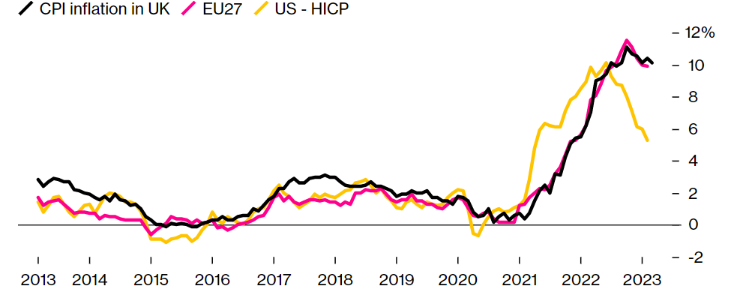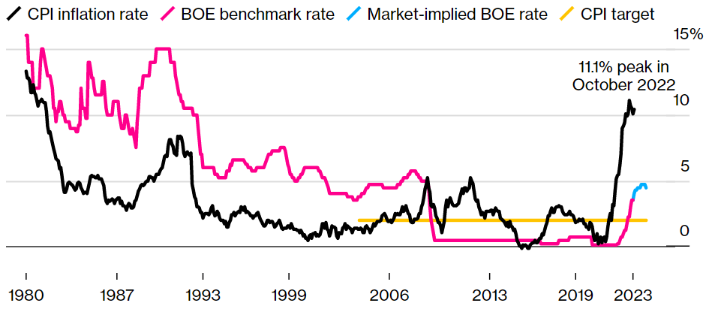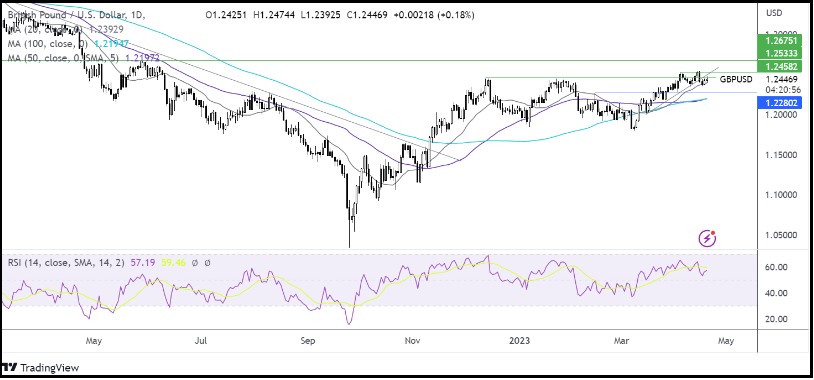The pound is the best-performing G10 currency this year, up around 3% against the US dollar since the start of the year, and it reached a 10-month high last week. In light of this week’s wage and inflation data, could the rally in Sterling continue?
GBP’s strong start to 2023
GBP has outperformed its major peers after rebounding spectacularly from the record lows against the U.S. dollar in September, following former Prime Minister Liz Truss’s mini-budget.
Coming into this year, the market was short sterling amid expectations of a deep recession and on the back of bleak economic forecasts from the likes of the IMF, the Bank of England, and the UK’s Office for Budget Responsibility (OBR).
The UK economy has so far performed better than expected in 2023, avoiding a recession, two consecutive quarters of negative growth. Services PMI, the dominant UK sector, has also rebounded back into growth. The OBR no longer expects a recession this year, and the IMF has upwardly revised its projection to -0.3% contraction from -0.6%. Moreover, the Citi Economic Surprise Index (CESI) shows that overall, economic data continues to outperform consensus estimates.
10%+ CPI
While the UK economy hasn’t fallen into recession yet, inflation hasn’t fallen notably either. UK CPI data this week showed that inflation remained in double digits for a seventh straight month at 10.1% YoY, down slightly from 10.4% in February, but missing forecasts of 9.8%, meaning that inflation is higher in the UK than in Europe or the US.

Source: ONS
Delving deeper into the figures, falling energy prices and motor fuels put downward pressure on inflation; food keeps upward pressure on prices. Food inflation was at 19.1%, the highest level since 1977. Services inflation was also unchanged at 6.6%, which the BoE will also be closely monitoring. Core inflation held steady at 6.2%, defying expectations of a fall to 6%.
Wages keep growing
The data comes hot on the heels of UK jobs data which showed that although unemployment ticked higher to 3.8%, average weekly earnings unexpectedly rose to 5.9% in the three months to February. Expectations had been for a fall in weekly average weekly earnings to 5.1%. Persistently high prices and wage growth will unnerve the BoE, raising concerns over a wage inflation spiral.
However, it is also worth noting that pay growth is lagging far behind inflation. According to the ONS, total pay fell by 4.1% on the year after taking inflation into account, one of the largest falls since 2009, keeping household incomes squeezed and the consumer under pressure. Meanwhile, workers are likely to keep striking while inflation remains high and real wages fall, which could raise the chances of a recession later in the year.
While the data this week have pointed to high inflation, there have been some signs of easing. The producer price index cooled significantly to 7.6% from 12.8%, which suggests that the peak input price growth may have peaked.
BoE to hike again
Stronger-than-forecast wage growth coupled with hotter-than-expected inflation means that the BoE’s work to tame inflation is clearly not done yet and still has a way to go. The data has revived expectations that interest rates in the UK still need to be hiked further and could remain elevated for longer.
Analysts at Goldman Sachs. Morgan Stanley and other investment banks have upwardly revised their BoE calls this week, from hold to a 25-basis point rate hike in May.
The money markets are now pricing in peak interest rates at 5%, with a 25-basis point hike in May and another in June.

Source: ONS
How to trade GBP?
While inflation is expected to fall from April as the base effect comes into play, inflation is still proving to be sticky, meaning the grind back toward 2% is likely to be long and slow. Interest rates could remain high for longer, which would be pound positive, particularly against other currencies where inflation is seen falling much faster, such as the US; where central banks have paused rate hikes, such as CAD, AUD, and against the JPY, given the BoJ’s dovish stance.
The risk to this outlook would be if the UK economy started decelerating rapidly and the economy tipped into a recession. Under these circumstances, the economy contracting would take the pressure off the BoE to hike rates or keep rates elevated and could put downward pressure on the pound.
GBP/USD technical analysis
GBP/USD ran into resistance at 1.2545 last week and is showing signs of losing momentum. The 20 sma has been offering support, and this will be a key level to watch at 1.24. A break below here opens the door to 1.2350, the weekly low, and 1.2275, the April low. Meanwhile, should buyers successfully defend the 1.24 level, buyers could look to rise above 1.25, the rising trendline resistance, and 1.2545, to create a higher high. Beyond here, bulls could target 1.2665, the May high.





